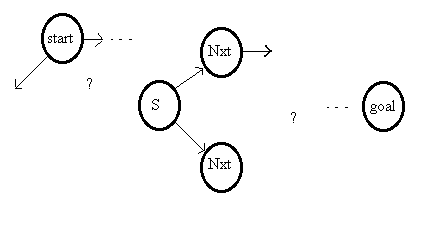
Fig. 2.16
The previous section discussed graph traversal for a static graph. The nodes and edges were given in advance, rather than calculated while searching for a solution.
Consider now situations where search can be specified by starting at a starting state, generating moves to next possible states, check that the move is a safe or allowable one, check that the next state has not been previously visited, and then continue the search from this next state. In Prolog, this specification could take the following explicit form:
solve(P) :-
start(Start),
search(Start,[Start],Q),
reverse(Q,P).
search(S,P,P) :- goal(S), !. /* done */
search(S,Visited,P) :-
next_state(S,Nxt), /* generate next state */
safe_state(Nxt), /* check safety */
no_loop(Nxt,Visited), /* check for loop */
search(Nxt,[Nxt|Visited],P). /* continue searching... */
no_loop(Nxt,Visited) :-
\+member(Nxt,Visited).
This is not a complete program, but is instead a superstructure on which a specific program can be constructed. It is a kind of generic search description. One needs to further specify:
next_state(S,Nxt) :- < fill in here >. safe_state(Nxt) :- < fill in here >. no_loop(Nxt,Visited) :- < fill in here >. /* if different from default clause */ start(...). goal(...).
A diagram depicting the search is as follows:

Note how similar this formulation is to the DFA parser of section 2.11 and the graph determination of section 2.12. The similarity is not mere coincidence!
As an example, let us reconsider the 8 queens puzzle of section 2.11. We will use a similar state representation. For example, choosing column 1 for the first row, column 3 for the second row and column 6 for the third row is represented as [6,3,1]. That is, if list L represents having already chosen for k rows (length L = k) then choosing C for the (L+1)st row is represented by the list [C|L]. Safety is calculated in a fashion similar to what was done previously.
start([]).
goal(S) :- length(S,8).
next_state(S,[C|S]) :- member(C,[1,2,3,4,5,6,7,8]),
not member(C,S).
safe_state([C|S]) :- length(S,L),
Sum is C+L+1, Diff is C-L-1,
safe_state(S,Sum,Diff).
safe_state([],_,_) :- !.
safe_state([F|R],Sm,Df) :- length(R,L),
X is F+L+1,
X \= Sm,
Y is F-L-1,
Y \= Df,
safe_state(R,Sm,Df).
Load both the generic search program and the code just previous, and try a goal ...
Notice that the solution is actually the last element, [4,2,7,3,6,8,5,1], of this list. The program generated this solution from right to left, but (because of the symmetry in this puzzle) its reverse is also a solution.?- solve(P). P= [[],[1],[5,1],[8,5,1],[6,8,5,1],3,6,8,5,1],[7,3,6,8,5,1],[2,7,3,6,8,5,1], [4,2,7,3,6,8,5,1]] Yes
Also, for this puzzle, there is no real need for the 'no_loop' calculation, since this search never repeats a state. For other applications, the loop check may be essential.
The inefficiency noted for the previous program in Section 2.11 (that the whole list was generated before checking safety) is NOT the case for the current program.
Exercise 2.16.1 The missionaries and cannibals problem is a good example of a puzzle that can be analyzed according to the search superstructure given above. The problem involves three missionaries and three cannibals, all six of whom are originally on one side of a river. There is one boat that will be used to ferry the missionaries and cannibals to the other side of the river. The boat holds two occupants at most, and there is no way to send the boat across the river without having at least one occupant in the boat. The threat is that, if the cannibals outnumber the missionaries in any circumstance, then the cannibals will cook and eat the missionaries (so the fable goes). Use the search superstructure to design a Prolog program that searches for ways to ferry all six persons to the other side of the river. Suggestion: Use state representation [M,C,B] where M is the number of missionaries and C is the number of cannibals on bank B. The start state is [3,3,left], and the goal state is [3,3,right]. Write specifications for 'start', 'goal', 'next_state' and 'safe_state', and add them to the search superstructure to obtain a complete program to solve this puzzle. Your program should be able to calculate two distinct minimal solutions each involving eleven boat trips across the river.
Exercise 2.16.2 Nilsson's A* algorithm is a good Prolog project. See the reference for Nilsson (1980). Develop a Prolog A* program superstructure and then use it to solve the 8-puzzle, which is also discussed in Nilsson's book. This is also the subject of Chapter 5 of the Prolog Tutorial.